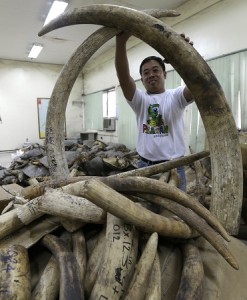
A staffer of the Department of Environment and Natural Resources-Protected Areas and Wildlife Bureau (DENR-PAWB) displays elephant tusks which were seized by Philippine customs authorities over a two-year period following failed smuggling attempts in the country, Wednesday September 26, 2012, in Quezon city northeast of Manila. The tusks are to be shipped back to their port of origin, mostly from Tanzania, for destruction. AP/Bullit Marquez
MANILA, Philippines—Philippine authorities said Friday they had launched a nationwide investigation into Catholic devotees collecting religious figures made of “blood” ivory smuggled from Africa.
The probe, launched this week, was initially focused primarily on one priest who was quoted in a National Geographic article allegedly giving instructions on how to smuggle ivory and naming carvers who would turn it into statues.
However the head of the National Bureau of Investigation’s environment division, Sixto Comia, said his officers had now also begun looking into other owners of ivory figures, amid concerns that the trade was extensive.
“This is a nationwide operation. Those people who like religious statues, especially the rich, they want ivory. Some of them know it is illegal but there are people still importing it,” he told Agence France-Presse.
“It isn’t just the priests we will be investigating. Anyone who we hear who owns banned ivory, we will file a case against them.”
He declined to give details, saying it might tip off suspects.
About 80 percent of the Philippines’ roughly 100 million people are Catholic, a legacy of Spanish colonial rule that ended in 1898.
Catholic statues have for centuries been made with ivory, however the church now officially condemns the practice to prevent the slaughter of elephants for their tusks.
Importing ivory has been banned in the Philippines since 1981. The maximum penalty for possessing illegal ivory is four years in jail.
However huge amounts of ivory have been seized in the Philippines in recent years.
The priest in Cebu named in the National Geographic article, Monsignor Cristobal Garcia, is well-known for having a vast collection of ivory statues.
The article said Garcia gave advice to the journalist on how to smuggle them into the United States.
After the National Geographic article, the Catholic Church revealed Garcia had been suspended in June after the Vatican began an investigation into allegations he sexually abused children three decades ago.
In a statement on Wednesday, the head of the Catholic Bishops’ Conference of the Philippines made no comment on either allegation.
But he criticized the National Geographic article for “religious bias”.

